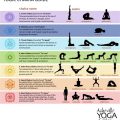Choosing the Right Yoga Style to Match Your Personal Goals
Yoga has evolved into an incredibly diverse practice, offering a wide range of styles suited to various goals, preferences, and fitness levels. Whether you aim to increase flexibility, reduce stress, build strength, or deepen your spiritual awareness, there’s a yoga style that can help you achieve your objectives. Understanding the nuances between different yoga styles is crucial to ensure that your practice aligns with your individual goals. This guide explores key yoga styles and offers insights into which may be the best fit for your specific aspirations.
Introduction
Yoga is more than just a physical practice; it’s a holistic system designed to balance body, mind, and spirit. The explosion of yoga styles in modern times has made it both accessible and confusing for newcomers and experienced practitioners alike. The key to maximizing the benefits of yoga is selecting the style that aligns with your personal goals. Whether you’re aiming for physical fitness, mental clarity, or spiritual growth, this guide will help you navigate the many types of yoga and match them to your unique objectives.
Key Concepts
Before diving into specific yoga styles, it’s essential to understand several core concepts that apply to all forms of yoga:
- Asana: The physical postures practiced in yoga.
- Pranayama: Breathing techniques that control the flow of energy (prana) in the body.
- Meditation: The practice of focusing the mind to achieve a state of inner calm and awareness.
- Mindfulness: The process of being fully present in the moment, often cultivated during yoga.
- Alignment: The correct positioning of the body in each pose to avoid injury and maximize benefits.
Historical Context
Yoga’s origins date back over 5,000 years to ancient India, where it began as a spiritual and philosophical discipline aimed at achieving self-realization. The word “yoga” comes from the Sanskrit root yuj, meaning to unite or join. Historically, yoga was a comprehensive practice that included physical postures (asana), breath control (pranayama), meditation, and ethical principles (Yamas and Niyamas).
In the late 19th and early 20th centuries, yoga began to spread to the West, where it evolved into various forms, often emphasizing physical postures over the traditional holistic approach. Understanding the historical roots of yoga provides valuable context for appreciating the diversity of modern styles and how they address different aspects of well-being.
Current State Analysis
Today, there are numerous styles of yoga, each catering to different needs and levels of experience. Some styles focus primarily on the physical aspects, emphasizing strength, flexibility, or endurance. Others prioritize mental and emotional well-being through meditation, breathwork, or relaxation techniques. Here’s a brief overview of the most popular yoga styles:
- Hatha Yoga: A general term for yoga that focuses on physical postures. Great for beginners and those looking for a slower-paced class.
- Vinyasa Yoga: Known for its fluid transitions and faster pace, Vinyasa yoga is excellent for building strength and cardiovascular endurance.
- Ashtanga Yoga: A rigorous, physically demanding practice that follows a set sequence of poses. Ideal for those seeking a disciplined approach.
- Yin Yoga: A slow, meditative style that involves holding poses for longer periods. Perfect for improving flexibility and calming the mind.
- Restorative Yoga: Focuses on relaxation and recovery through gentle postures supported by props. Great for stress relief and injury recovery.
- Kundalini Yoga: Combines postures, breathwork, and chanting to awaken dormant energy (kundalini) at the base of the spine. Best for those seeking a spiritual or energetic practice.
Practical Applications
Matching your goals to a specific yoga style is key to optimizing the benefits of your practice. Below, we break down common personal goals and the yoga styles that best support them:
| Goal | Recommended Yoga Style | Benefits |
|---|---|---|
| Improve Flexibility | Yin Yoga, Hatha Yoga | Long-held postures target connective tissues and increase range of motion. |
| Build Strength | Ashtanga Yoga, Vinyasa Yoga | Dynamic sequences and weight-bearing poses build muscle strength. |
| Reduce Stress | Restorative Yoga, Yin Yoga | Slow, calming postures promote relaxation and reduce cortisol levels. |
| Spiritual Growth | Kundalini Yoga, Bhakti Yoga | Meditation, breathwork, and chanting enhance spiritual awareness. |
| Improve Mental Focus | Vinyasa Yoga, Ashtanga Yoga | Fast-paced sequences require concentration, boosting mental clarity. |
| Enhance Recovery | Restorative Yoga, Gentle Yoga | Low-impact poses supported by props allow for recovery from injury or intense workouts. |
Case Studies
Several real-world examples highlight how different yoga styles align with individual goals:
- Case 1: The Athlete – A professional soccer player incorporates Vinyasa Yoga to improve flexibility and prevent injuries while maintaining cardiovascular fitness.
- Case 2: The Busy Professional – A corporate executive turns to Restorative Yoga to manage stress and improve sleep quality.
- Case 3: The Spiritual Seeker – A Kundalini yoga practitioner experiences profound shifts in energy and spiritual awareness through regular practice of breathwork and chanting.
Stakeholder Analysis
Several groups can benefit from yoga, each with its own set of needs and goals. Here’s an analysis of the key stakeholders in the yoga community:
- Beginners: Seeking guidance and clear instructions, typically opt for Hatha or Restorative yoga to ease into the practice.
- Fitness Enthusiasts: Often prefer more vigorous styles such as Vinyasa or Ashtanga to complement their existing workout routines.
- Spiritual Practitioners: May be drawn to Kundalini or Bhakti yoga for its emphasis on meditation and inner work.
- Healthcare Providers: Recommending yoga to patients with anxiety or chronic pain, focusing on Restorative and Yin yoga for therapeutic benefits.
Implementation Guidelines
For those looking to implement yoga into their lifestyle, here are some practical tips:
- Start Slowly: If you’re new to yoga, begin with a gentle style like Hatha or Restorative yoga to avoid injury and build a solid foundation.
- Listen to Your Body: It’s important to respect your limits. Avoid pushing too hard, especially in more intense styles like Ashtanga or Vinyasa yoga.
- Create a Routine: Consistency is key. Try to practice at least 2-3 times per week to see real benefits.
- Incorporate Breathwork: Regardless of the style, make time for pranayama (breathing exercises) to calm your mind and enhance focus.
- Seek Professional Guidance: If you’re unsure which style suits your needs, consult with a certified yoga instructor who can tailor a practice to your goals.
Ethical Considerations
Yoga comes with its own set of ethical guidelines, often rooted in the Yamas and Niyamas, the moral and ethical principles of yoga. Practitioners should consider the following ethical considerations:
- Respect for Tradition: While modern yoga has evolved, it’s important to honor its spiritual and cultural roots.
- Avoiding Injury: Practicing mindfulness and avoiding overexertion to maintain both physical and mental well-being.
- Inclusivity: Yoga should be accessible to people of all backgrounds, body types, and experience levels.
Limitations and Future Research
While yoga offers a wide range of benefits, it’s not a one-size-fits-all solution. Certain styles may not be suitable for individuals with specific health conditions, such as high blood pressure or chronic injuries. Additionally, more scientific research is needed to validate some of the health claims associated with different styles of yoga, particularly in the areas of mental health and chronic pain management.
Future research should also explore the long-term effects of yoga on mental well-being and cognitive function, as well as its potential role in addressing societal issues such as stress in the workplace. As the field of yoga therapy grows, it will be important to maintain rigorous standards to ensure both safety and efficacy for diverse populations.
Expert Commentary
The right yoga practice is deeply personal and should reflect not only your physical abilities but also your mental and emotional needs. As Dr. Aria Roberts, a wellness expert, puts it: “Yoga is not about mastering a pose; it’s about learning to listen to your body and mind. The most effective yoga practice is one that aligns with your life goals, whether that’s reducing stress, building strength, or fostering a deeper sense of self-awareness.”
From athletes to busy professionals, yoga can be adapted to suit a wide range of needs. However, the real power of yoga lies in its ability to transform your overall well-being by creating balance—physically, mentally, and emotionally.








